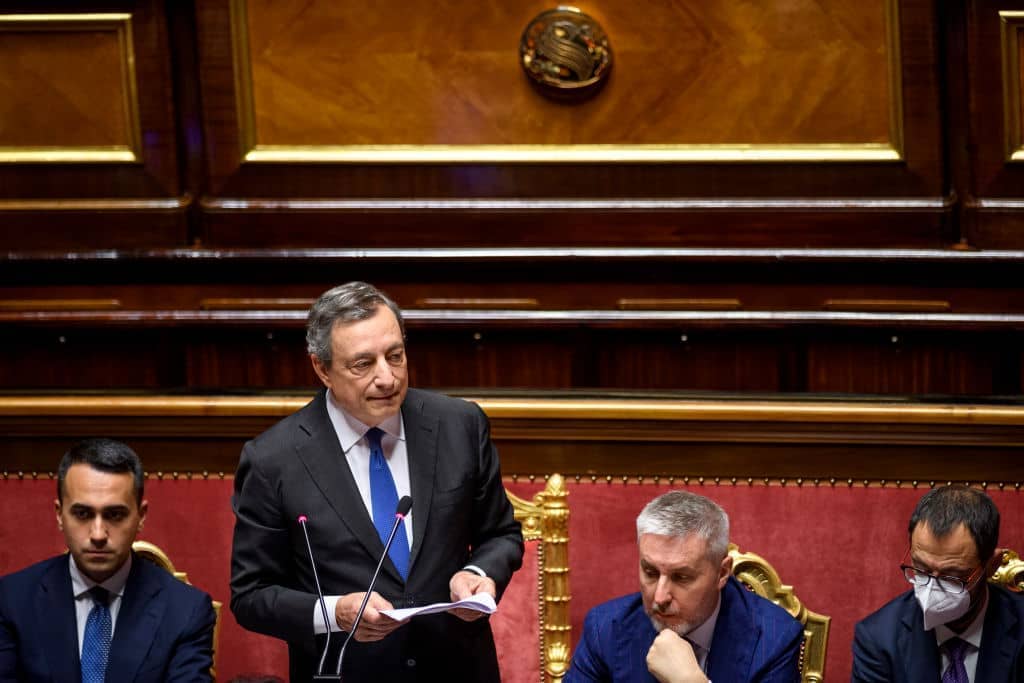Mario Draghi has resigned as Italian prime minister – for the second time in a week. But this time his resignation was accepted by President Sergio Mattarella, with a snap election expected in September or October. The resignation came after a fiery debate in parliament yesterday in which the populist Five Star Movement joined the right-wing League and Forza Italia parties to abstain on a vote of confidence in Draghi’s national unity coalition, which was ushered in and saw Draghi installed, unelected, as PM during the pandemic.
Draghi will stay on as a caretaker prime minister until the autumn but he is leaving Italy in a state of economic chaos
The vote of confidence came after Draghi’s predecessor, Giuseppe Conte, refused to lead his Five Star party into supporting a cost-of-living support package. Conte argued that Draghi’s support for Italians was insufficient, and follows months of accusations that Italy is spending too much on help for Ukraine at the expense of the domestic population. Luigi Di Maio, Italy’s foreign affairs minister (who walked away from Five Star earlier last month in protest at his party leader Conte’s failure to support Draghi’s policies), wrote on Twitter yesterday that the decision was ‘a black page for Italy’. He added: ‘Politics has failed, in the face of an emergency the answer has been that of not knowing how to take responsibility for governing. We played with the future of the Italians. The effects of this tragic choice will remain in history.’
As it stands, Giorgia Meloni, leader of the far-right Fratelli d’Italia (Brothers of Italy), is the favourite to become the next prime minister, most likely leading a coalition government of Italian right-wing parties. Polling suggests such a coalition would probably win an election outright: the first time a right-wing government would be formed since 2008. The rightist bloc, consisting of Fratelli d’Italia, League and Forza Italia could win 221 of the lower house’s 400 seats, and 108 of 200 seats in the upper house. The political turmoil has driven a wedge between the centre-left Democratic Party and Five Star, splitting the vote on the left. Italian politics is known for its fractious nature, and the infighting between the parties involved in Draghi’s national unity coalition has unwittingly paved the way for a stronger coalition of right-wing parties to take power at the next election. After Boris Johnson, Draghi may become the second world leader whose loss is lamented by Ukrainians. A Meloni-led coalition would probably send less money to Ukraine, and may even include Silvio Berlusconi: he has denounced Putin’s invasion but the two were close friends for two decades.
Draghi will stay on as a caretaker prime minister until the autumn – when Italy’s budget is usually agreed – but he is leaving Italy in a state of economic chaos. Inflation in the country is at 8 per cent (the highest level since the mid-1980s). Political instability isn’t helping things: the Milan stock market dropped a further 2 per cent after the news about Draghi emerged. The country’s ten-year bond yield hit 3.6 per cent, widening the gap between equivalent yields in Germany, driving up fears of another Eurozone crisis. It’s this fear that has led the European Central Bank to be slow on raising rates. When it did so in 2011, a year later Draghi, the then governor, promised to do ‘whatever it takes’ to fix the debt crisis it sparked. This morning the ECB raised rates by half a percentage point. Draghi’s departure will not have calmed its nerves.
Policymakers are increasingly worried about runaway prices, while the European economy remains heavily damaged by the effects of sanctions on Russia and the war in Ukraine. The hike spells a difficult new period for the Eurozone, which is crippled by inflation at 8.6 per cent, and piles pressure on the next Italian prime minister, who inherits a country wounded by years of political, and economic, instability.







Comments